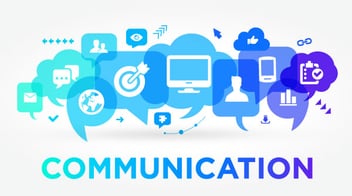Adapting to Member Feedback: 5 More Best Practices for Effective Communication
In our last article, Communicating the Value of Membership: 6 Best Practices for Effective Communication, we discussed how your relationship with your members can only be as strong as your ability to communicate. After all, your outreach program is the best way for you to showcase all the many benefits of membership.
If your communication efforts don’t have a clear message, or if they aren’t being seen in the first place, then it’s your relationship with members that will suffer the most.
Consider these statistics which show what people expect from communication with the businesses they frequent:
- 51% of U.S. consumers are loyal to brands that interact with them through their preferred channels of communication (Accenture)
- 95% of customers are looking for some degree of proactive communication from the companies with which they do business (Loyalty360)
- Successful execution of loyalty program communications can result in up to 10x lift in personalization (Bond Brand Loyalty)
- 64% of consumers are more likely to recommend a brand to others if it offers a simpler experience and communications (iperceptions)
But effective communication is more than just getting your message out there. It’s about listening too. Organizations that are willing to hear their members, respond and act on good suggestions will grow even closer to their members.
Communicating Both Ways: How to Listen and Respond
Hopefully by now you have a solid message that people are seeing. When this happens, it naturally follows that people want to keep the conversation going by responding back.
Some will volunteer their comments and questions, some will only give you their valuable insights if you ask. Either way, when you open yourself to feedback, you can grow ever closer to your audience.
Best Practice 1: Ask for Targeted Questions for Feedback Frequently
If you’ve been keeping track of member interactions, you probably have a fair amount of data accumulated already. You’ll know how well an email performs based on its open rate, click through rate, etc. You’ll know what percentage of members attended the most recent gala.
 However, there are a lot of data points you’ll never know unless you ask for feedback. These include factors like how a member feels about the organization, and how likely they are to refer a friend to join.
However, there are a lot of data points you’ll never know unless you ask for feedback. These include factors like how a member feels about the organization, and how likely they are to refer a friend to join.
Not only will it help your organization improve, it actually strengthens your connection to members when you ask for their opinions. It helps them know that you care what they think.
Younger generations especially value inclusivity and connectivity. They nearly demand that organizations involve them in the decision making process. At the very least, they’ve proven themselves likely to leave if they feel unheard.
Any feedback at all will be valuable. However, you’ll get the most actionable data from targeted questions with answers you can quantify. Doing so will help you segment your members into marketing groups customized to their personal level of engagement.
Best Practice 2: Respond Where Many Can See
Surveys aren’t the only way to get member feedback. One of the great advantages of social media is that it throws the doors of communication wide open. First of all, it provides a medium through which members can interact directly with their organizations, asking questions, leaving feedback, requesting help, etc. It’s also an easy format by which the organization can quickly provide a response.
But the true strength of social conversation is that other members (and potential members) can see these positive interactions.
And before you ask – yes, sometimes members complain publicly. With a level-headed answer, however, you can not only bring an angry member back to your side, you’ll show many others that you are responsive and reasonable. That will be a huge mark in your favor.
Best Practice 3: Train Employees on Positive Interactions
 Employee interactions with your members can make or break the entire member experience. They are that powerful. So if you want to improve member engagement, you’ll need to make sure your employees are fully engaged too.
Employee interactions with your members can make or break the entire member experience. They are that powerful. So if you want to improve member engagement, you’ll need to make sure your employees are fully engaged too.
Having world-class customer service is going to be a great investment for your business. On one survey, 76% of respondents said customer service is a true test for how much a brand values them. We’ve found that a good interaction with a customer service representative can rectify most problems with a product or service, leaving the customer even more loyal than before.
For a comprehensive exploration of superior customer service essentials, check out the articles: Customer Service: Your Loyalty Program's Secret Weapon and From Bare Minimum to Concierge Level Customer Service: How to Build Your Arsenal
Employees can often solve problems and mitigate issues on the spot. Even when they can’t, they are a powerful tool to gather the information you need to make bigger decisions down the road.
Value Worth Communicating: What to Offer
Many organizations have been able to perfect their messaging by seriously considering member feedback. But what if your feedback is revealing deeper issues?
If you’re having trouble spreading a compelling message, then perhaps your member benefits are shallower than you thought?
If so, you might consider branching out to provide benefits with universal value.
Best Practice 4: Shore Up Your Core Offerings
At Access, we work with hundreds of organizations and their cumulative millions of members. We noticed just how many leaders were relying on guesswork and assumptions to identify member needs. Some simply lacked member input, while others were gathering feedback, but failing to act on it.
This growing gap between organization leaders and their members has led to an overestimation of the value of their benefits by an average of 27%.
 This e-book can help guide you in ensuring that your value proposition is really in line with what your members want.
This e-book can help guide you in ensuring that your value proposition is really in line with what your members want.
In the study, surveyed leaders overvalued benefits relating to social events and causes as compared to their members. Monetary and economic benefits (like member-only discounts, travel packages, etc.) were the only benefits that leaders underestimate in value.
You’ll have to survey your own members to see if there’s a disconnect between what you assumed they valued most and what they actually value. If you find one, you’ll have to decide if correcting it will mean changing up your messaging or changing up your benefits.
Best Practice 5: Enhance Your Core Offerings with Added-Value Benefits
Your core offerings are of great value, to be sure. After all, they’re the main reason your members are attracted to you. Offering the right value-added membership benefits, however, can provide multiple benefits of its own.
Benefits that deliver a clear value to which you can assign a dollar amount makes it easy to communicate a membership’s return on investment. After all, the price tag of membership has a clear dollar amount listed on the cost. Members are reminded of their investment every time dues come due.
Many of the benefits of membership have a more subjective value. The worth of a social networking opportunity, industry education, advocacy, etc don’t come with a dollar value.
But certain value-added benefits like discount programs aid in putting a dollar amount to the value of membership too. For example, many of the organizations that work with Access Development, the nation’s largest private discount network, report that members are able to save more than the cost of membership.

Messaging like that offers a straightforward value that is quick to explain and simple to understand.
Plus, membership discount benefits give you a reason to contact members even more often. When you alternate reinforcing your organization's mission with high-value offers to benefit other aspects of their lives, your messages won't feel repetitive.
In fact, when you help people afford fun things like travel, entertainment and dining out, those messages often have high engagement levels. This can be true whether yours is a professional association helping members advance careers or an organization connecting them to a hobby.
Just be careful in your selection of discount provider partners. Some may broadcast their inexpensive or free price tag. However, they’re usually full of aggregated, low value offers that can do more harm than good to your member relations.
The best discount programs offer local, in-store deals at the places your members already frequent. This will make it a benefit they use, love and thank you for.
Up Your Communication Game
You can (and should) strengthen your relationship with members by upping your communication game. With communication best practices and a clear message of value (and of course a whole lot of actual value to talk about) you can forge an unbreakable bond.
Want more information on how to become a better communicator? Here are some related articles to get you started.
Topics: Customer Engagement, Discount Programs, Member Benefits, member engagement, association marketing, Membership Organizations

Written by: Kendra Lusty




.jpeg)







Share your Comment.